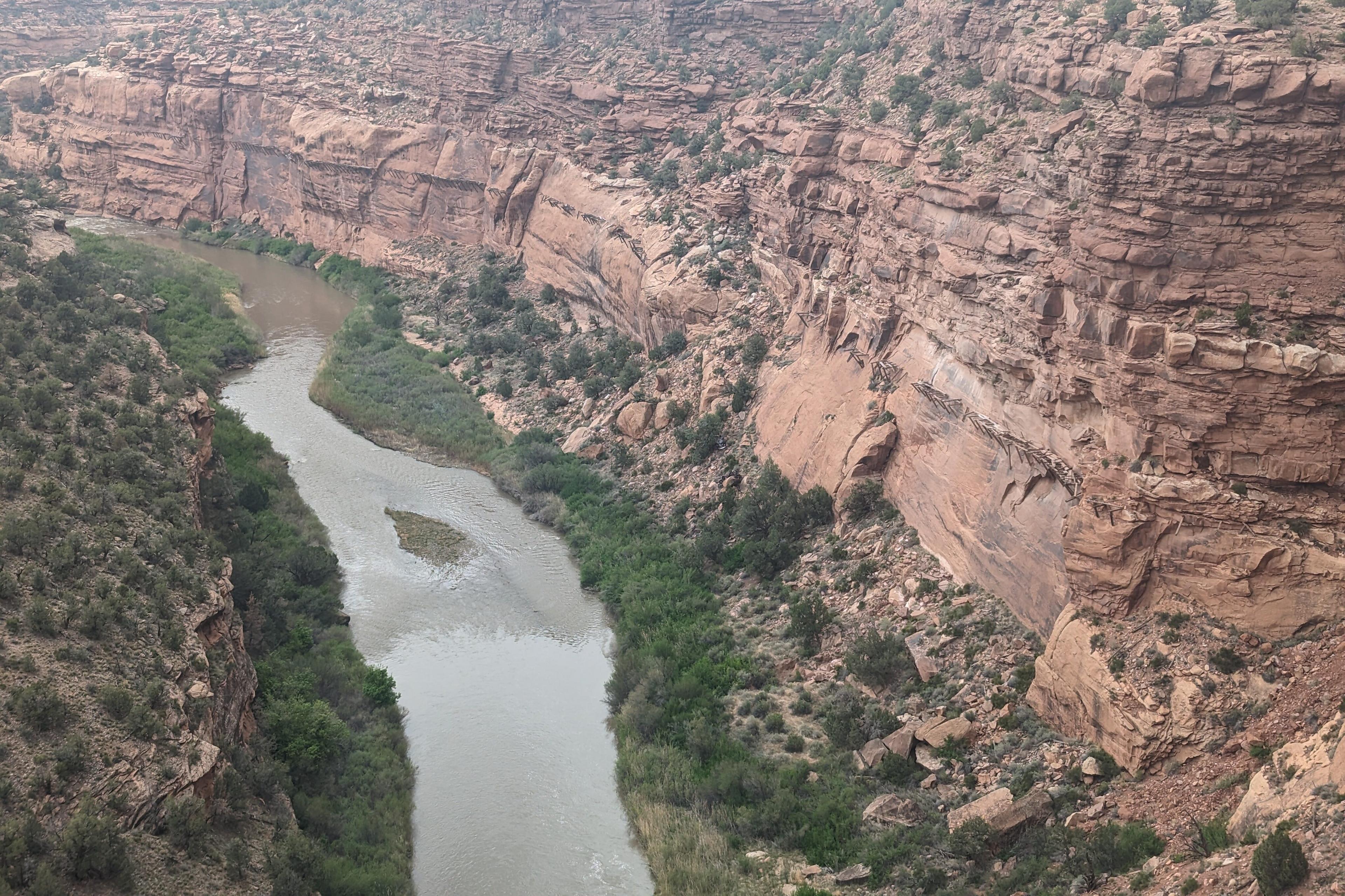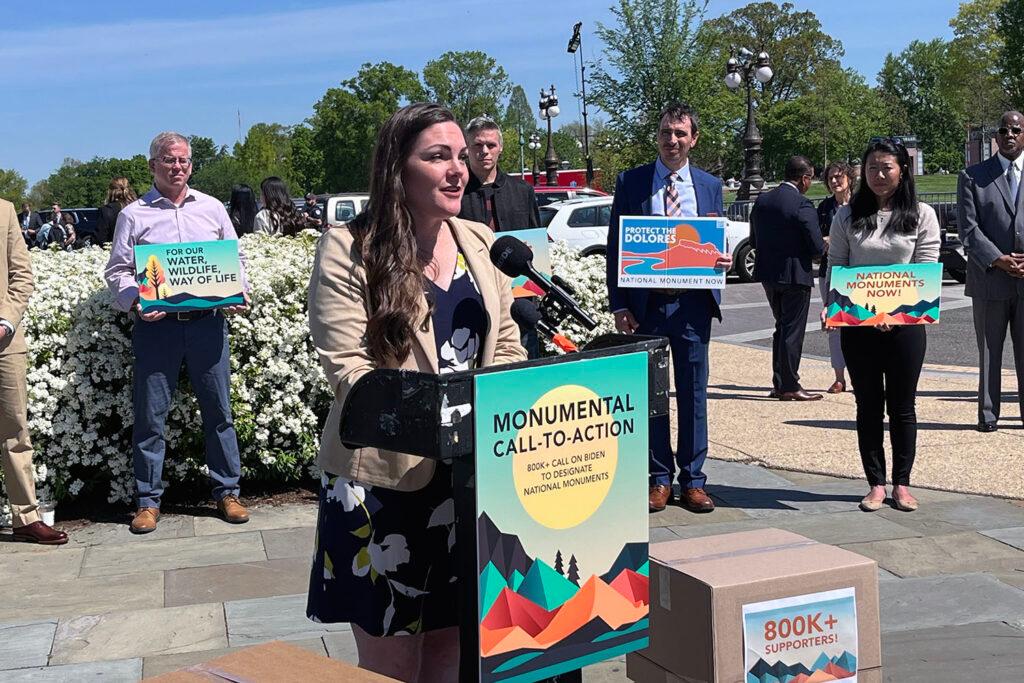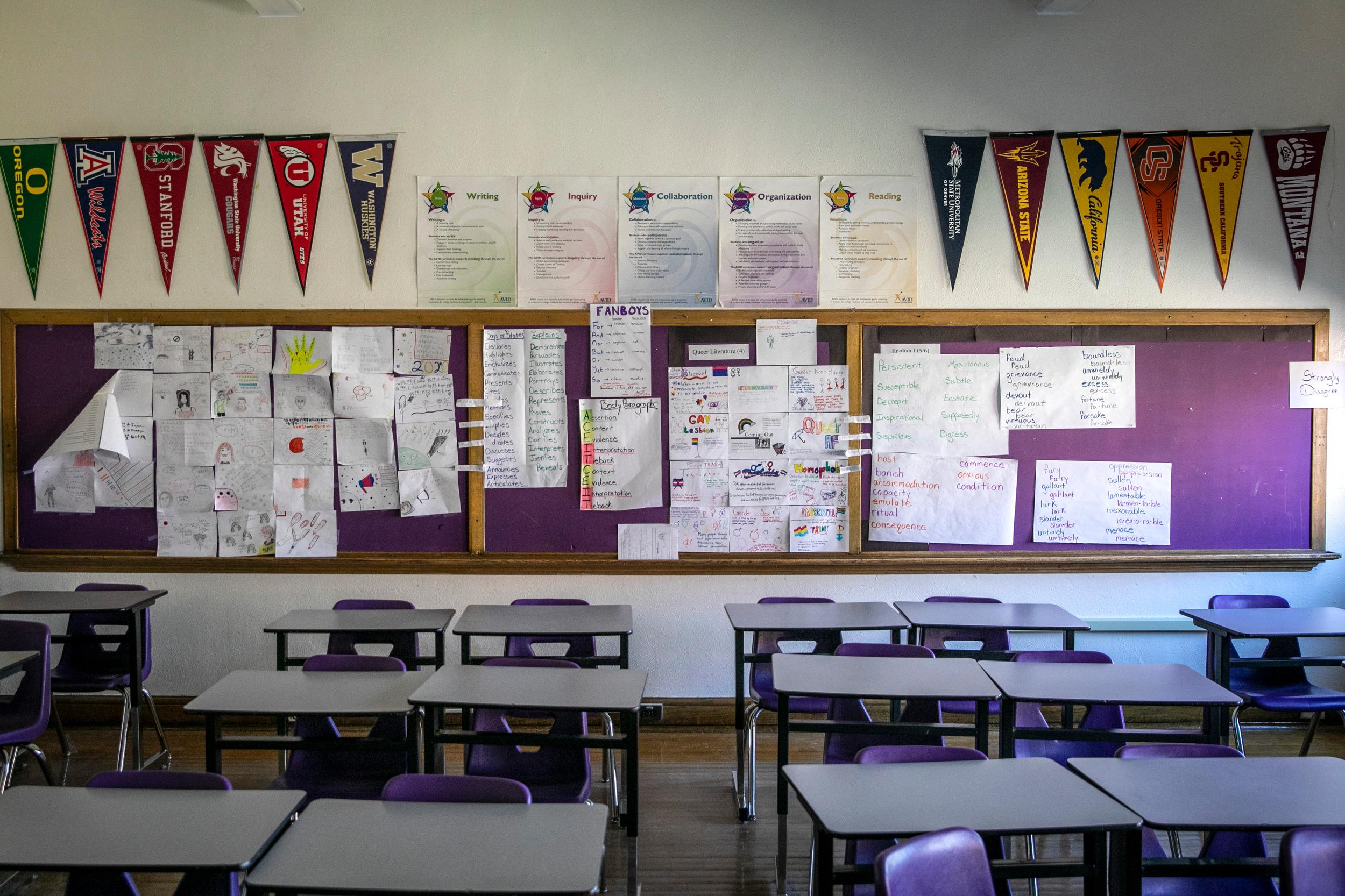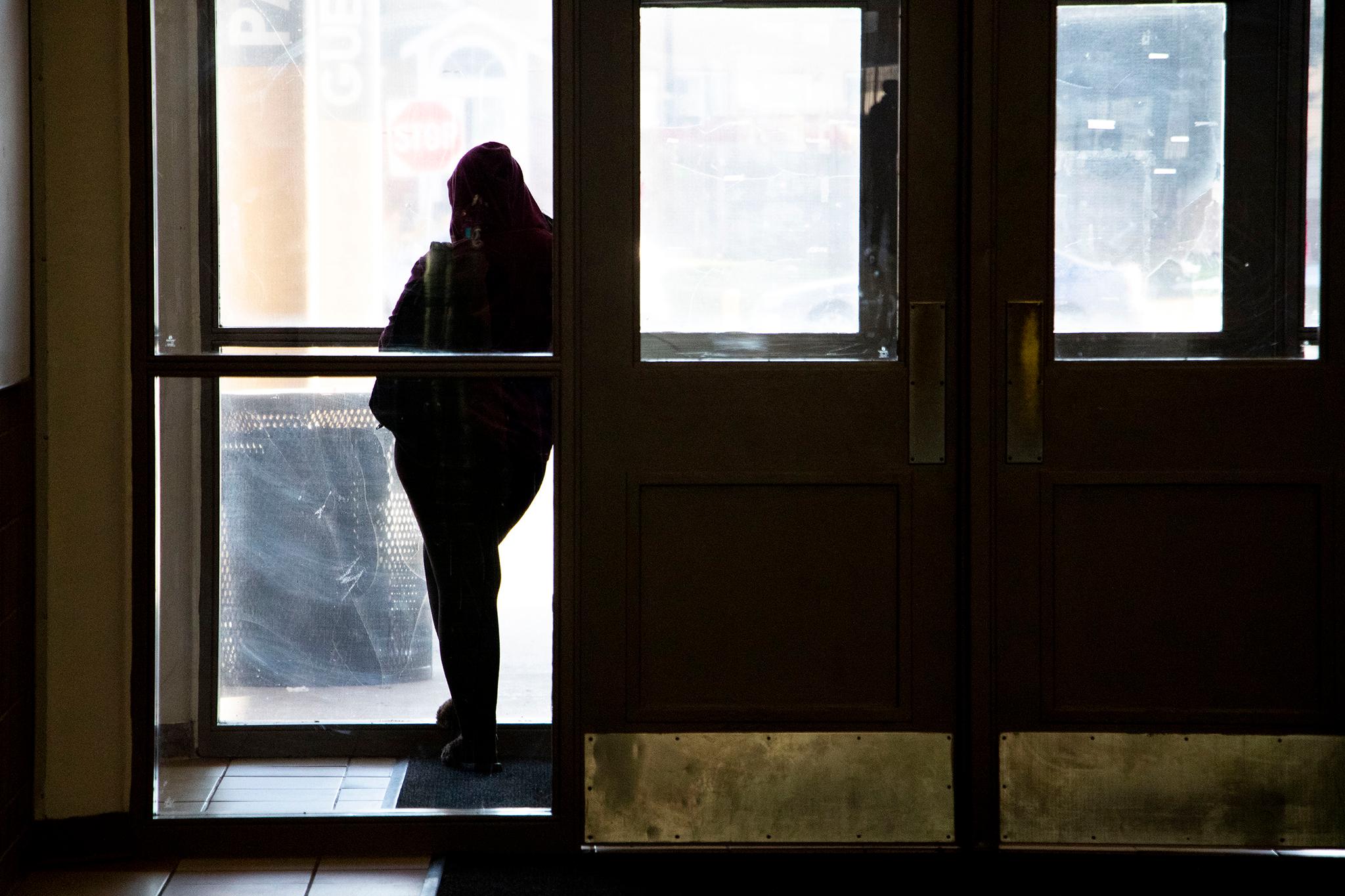
If the shirt is black, with orange lettering, expect to hear about western Montrose County’s legacy of mining, ranching and local stewardship over lands that do not need more bureaucratic oversight — or visitation.
If the shirt is blue, with white lettering, the conversation will drift toward an iconic but struggling portion of Colorado that could be damaged permanently without a prompt and robust conservation effort.
The garments, signs and slogans are shorthand for a debate playing out in Western Colorado over how to protect an expansive, sensitive landscape that’s heralded for its vistas, despite being relatively unknown. It’s also drawn renewed attention to the political question of when it’s appropriate for a president to use their power to unilaterally protect an area by making it a national monument.
“The Dolores River is on the same level as the Grand Canyon and the Salmon River in Idaho. If those places deserve increased federal protection, the Dolores River Canyon absolutely does,” Josh Munson, author of the “Guide to the Dolores River of Colorado & Utah,” told Senator John Hickenlooper at a recent listening session in Grand Junction. “I encourage you to support the monument designation for its beauty, for its resources and to protect it for all future generations and for all Americans.”
The proposal in question asks for a monument designation for around 400,000 acres of already-public land in Montrose and Mesa Counties that make up a portion of the Dolores River Canyons region. Backers are specifically calling for a national monument and not a national park, allowing the Bureau of Land Management and National Forest Service to continue to oversee the area.

Colorado’s congressional lawmakers have offered a different path to protection — turning the southern portion of the Dolores River into a national conservation area, but that effort has not been able to break through a gridlocked Congress.
In contrast, a monument designation could be done on the sole authority of the president through the Antiquities Act — a 1906 law signed by Theodore Rosevelt that allows presidents to protect federal lands of natural, historic or scientific significance.
The Act was used to designate the Colorado National Monument and as the first step in the creation of Great Sand Dunes and Black Canyon of the Gunnison national parks. Most recently in Colorado, President Joe Biden invoked it for the designation of the Camp Hale - Continental Divide National Monument in October, 2022.
Protect The Dolores advocates say a monument designation is a needed step in a time of legislative gridlock and mounting threats to sensitive landscapes.
Opponents of the plan — the Halt the Dolores Monument group — describe the proposal as a “land grab” that will upend the legacy of the region known locally as the West End by disrupting cattle ranching, closing the door on mining and inviting thousands of tourists to a landscape ill-equipped to handle them.
From Washington to the West End
While the proposal affects two counties in Western Colorado, a big portion of the conversation is taking place in Washington D.C. — where a monument designation could serve as an end run around legislative and local inaction.
Supporters of the monument idea, including local and tribal leaders, went to the U.S. Capitol to make their case in April.
“This is about preserving cultural heritage sites. This is about preserving indigenous sites. This is about preserving even our beautiful storied mining history in the area,” Grand Junction Mayor Anna Stout said.

Stout joined Colorado Wildlands Project Executive Director Scott Braden in making the case to lawmakers that the Antiquities Act could achieve what legislation and local discussions have been unable to finish.
For years, local advocates have worked to create a National Conservation Area that would balance the interests of conservation and land use along the river, all the way from the McPhee Dam in Montezuma County to the Utah border in Mesa County. Stakeholders in the southern portion of that region have reached an agreement, which has support from Colorado’s congressional delegation, including the area’s representative, GOP Rep. Lauren Boebert. That measure has yet to clear Congress, however.
The problem is the national conservation area effort has stalled at the Montrose County line. That’s led backers to pivot to the idea of a monument in both Montrose and Mesa counties. But they’ve been met with intense local pushback from the West End in particular.
“We see ourselves as definitely in the midst of the process still, and still wanting and seeking to do a lot of stakeholder outreach,” Braden said. “The intensity of the opposition, especially online, has slowed down the ability to have some of those conversations. It's added a lot of heat to the room.”
Opponents of the monument said they felt like the idea was sprung on them, with Montrose County Commissioner Roger Rash calling it “extortion.” The county’s board of commissioners passed a resolution formally opposing a monument designation in March.
Fellow commissioner Sue Hansen said the resolution was really about putting the monument idea on pause for the time being while more on-the-ground work is done.
“Let's think about a better way to do it,” she said. “If it's gonna be a national monument, we think instead of going with the Antiquities Act, it would be better to put it into a legislative action, so you could have proper stakeholder input, which is really important.”
The “Halt The Dolores Monument” effort is being spearheaded by Sean Pond, an RV park owner in the West End. Pond said he only learned about the proposal in February.
“I didn't realize this was half-a-million acre land grab. I didn't realize a lot of things in the early days, but I was asked to spread the word by a concerned ranching family so I did,” Pond said.
Pond, and other opponents in the areas adjacent to the proposed monument’s borders, said they felt like the push was coming from outsiders who are disinterested in hearing their concerns.
But Braden pushed back on that idea, saying his group has met with legislators, local elected leaders and impacted communities for the last six months.
Two listening sessions two hours apart
Sen. Hickenlooper entered the monument conversation in April with a West Slope trip focused on the region and the debate.
Hickenlooper has not taken a position on the monument idea. As a part of the tour, Colorado’s junior senator and former governor scheduled listening sessions in Naturita and Grand Junction, where he was met by two very different audiences.
In Naturita, Hickenlooper heard overwhelmingly from opponents. Some of the few comments in support were met with “boos” from the crowd.
The town of 500 sits in the part of Montrose County that would be most affected by a designation — a rural area that’s home to ranching, mining and very few people compared to the rest of Colorado. While the specifics of a monument designation are still in flux, many at the Naturita event worried such a change would close off future mining, reduce grazing opportunities for cattle and make Nucla and Naturita look more like Moab or Telluride: mobbed with visitors to the detriment of locals.
“Outdoor recreation is the infrastructure by which we connect to nature,” Nucla-based filmmaker Dani Reyes-Acosta told Hickenlooper. “It is not a tourist attraction to bring people in — maybe spend some money — and leave.”
At the following day’s listening session in Grand Junction, recreationists made the same points about the restorative elements of nature, but landed on a different conclusion, advocating that such properties should motivate further protections for the lands.
“I grew up camping in Gateway, Colorado, on the banks of the Dolores River and it shaped me as a person,” Teal Lehto said. “It helped me decide who I was going to be and it instilled a deep love for the outdoors and an appreciation of natural resources, particularly for water, which inspired my entire career as an environmental activist, raft guide and leave-no-trace educator. I want to make sure that other people have the same opportunities and experiences to explore our public lands and find themselves and develop a connection to the natural world.”
In general, this meeting at a theater at Colorado Mesa University tilted heavily toward the Protect The Dolores coalition, though opponents of the measure did turn out — and at several points were invited to the front of the line by the senator in order to hear both sides of the conversation.
One thread running through both discussions is the West End’s mining legacy. At one point, uranium mines in areas around Naturita and Uravan were among the most productive in the world. Opponents of the monument worry it would close off access to the Uravan Mineral Belt and take a future economic driver off the table entirely. Many speakers wondered if tensions in Ukraine, Gaza and Taiwan might prompt a need for more American uranium.
“Our country right now is wanting us to develop more of our own resources. We have those resources here,” said Bob Larson, a former geologist, in speaking to Hickenlooper in Naturita.
The next day, 100 miles north on Highway 141, advocates rejected the idea that the Uravan Mineral Belt would be entirely closed off, but said the designation could help protect the river from any future lithium mining in the area.
Tony Bates, a mining engineer, also argued that uranium extraction is an inherently unstable industry.
“My understanding is that the existing mines are excluded from the proposed monument. For mining to be stable in this area, the price has to stay high, but it won't stay high because other countries — Canada, Australia, Kazakhstan — have lower mining costs. Therefore mining is not a stable economic base for the West End,” Bates said. “The West End struggles economically. The proposed monument will provide another opportunity to develop a more stable economy.”
Throughout both listening sessions, Hickenlooper appealed to civility and understanding between the groups. In Naturita, former GOP State Sen. Don Coram, serving as moderator, repeatedly noted that he and Hickenlooper regularly disagreed “but were never disagreeable.”
Despite the reminders, the listening sessions were not without the occasional jeer, particularly in Naturita where Coram had to chastise the audience for booing a speaker from Telluride.
While the fight has gotten particularly nasty online, there were occasional signs of mutual respect. In Grand Junction, after lamenting what she saw as the failures of Just Transition pledges — a program designed to help communities transition after the loss of industries like mining — Aimee Tooker of Nucla was applauded by a subsequent pro-Monument speaker for voicing her concerns. The two hugged afterward.
Hickenlooper told reporters following the event in Grand Junction that he felt there was common ground between the groups, even if the most fervent moments of the weekend — or comments on Facebook — might suggest otherwise.
“Once people hear all the sides, I think they will be more willing to compromise. Maybe not get what they want, not their perfect outcome, but they'll get (to), ‘yeah, I can live with that.’ And that's where generally that outcome is the more durable, lasting benefit to a community,” Hickenlooper said.
There has still yet to be any introduction of legislation to protect the Dolores in either Mesa or Montrose counties in Congress, and Biden has not given any indication that he’d use his presidential powers there.
Hickenlooper said he plans to spend the next few months taking more feedback before landing on a position.
Timing could be crucial for backers though. President Biden has been open to using the Antiquities Act, but former president Donald Trump shrank national monuments during his first term, and would be unlikely to favor designating new ones, should he win a second term.
Hickenlooper said he does not feel the looming election is a reason to rush his decision to either support, oppose or offer an alternative option regarding the monument. Still, he doesn’t want to keep people waiting, either.
“Too often things take forever, and I don't have a timeline in terms of any presidential election, but I do think that all parties involved deserve to have a sense of urgency and that their time matters and that we shouldn't spend the next five years debating this,” Hickenlooper said.








